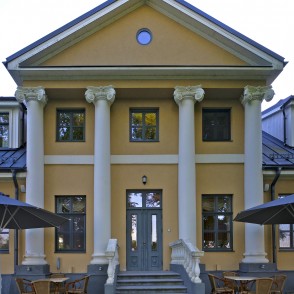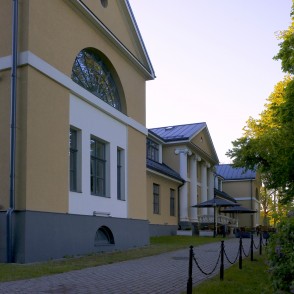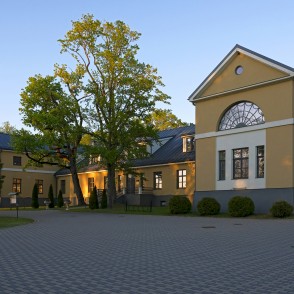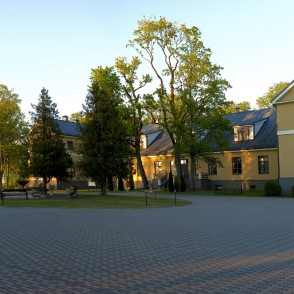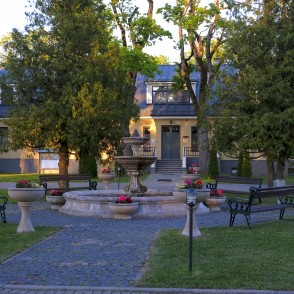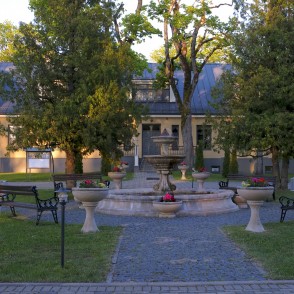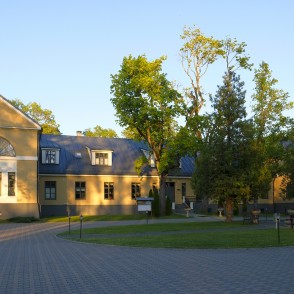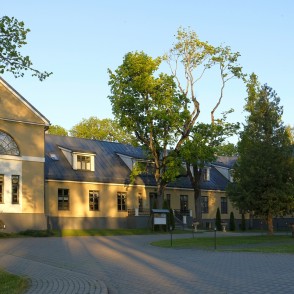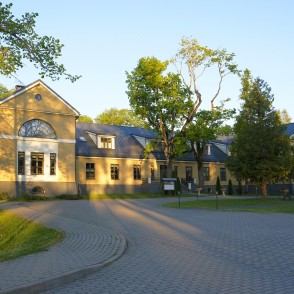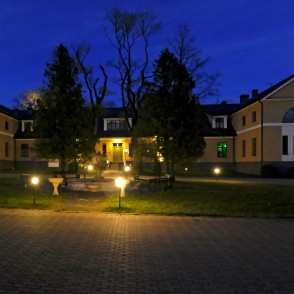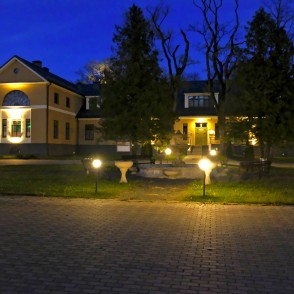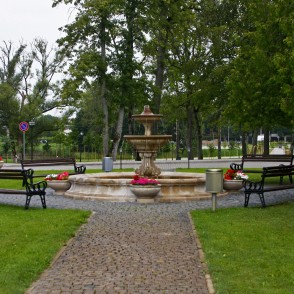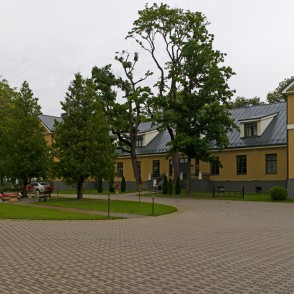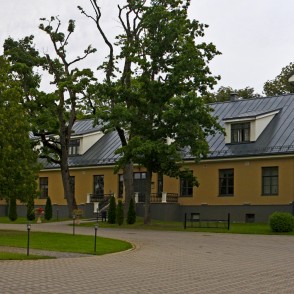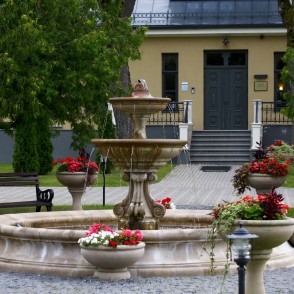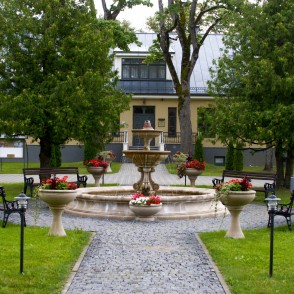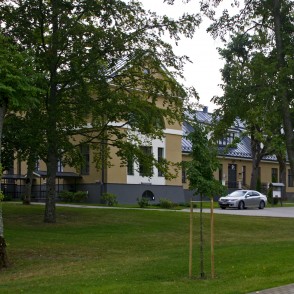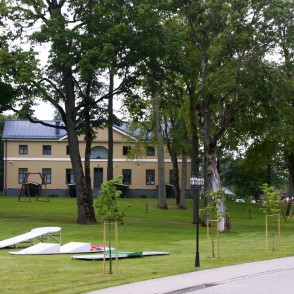Skrunda Manor is located high on the banks of Venta, and it is built in style of classicism at the beginning of 19th century. Skrunda Manor, master’s house, called a Palace among Skrunda inhabitants, was build during the management of the tenant count Gustav von Lamsdorf, who arrived here from Saint-Petersburg to spend beautiful old age here. Under the times the Manor has been significantly reconstructed, because after it had been a home for estate managers and shelter for nobleman who had fallen in mercilessness, it served also as prison, poorhouse, and chemist’s shop, school and boarding school.
Since 2012 Skrunda Manor is fully renovated and complies with the highest quality standards, being a significant project in Latvian cultural environment. Today Skrunda Manor offers its guests a hotel with 12 comfortable rooms, banquette halls and conference areas. The Skrunda Manor restaurant serves banquettes and individual guests. A pleasant historical atmosphere combined with modern technologies and equipment create an aura of the past without getting away from the present.
Skrunda Manor is located high on the banks of Venta, and it is built in style of classicism at the beginning of 19th century.
The Manor justly is called the miniature copy of Mezotne Palace – due to its architecture and visual lines, which in the surveys of Latvian historian Arturs Henins, among them in the edition “Ventas sakta” (“Sakta of Venta”) are explained by Mezotne Palace design of Johan George Adams that is used for construction of Manor building. In different chronicles and lists of the municipal real estate Skrunda Manor is mentioned also as a Palace.
Skrunda Manor Palace – “the last ray of classicism sunset”
Skrunda Manor is a characteristic model of architectural classicism – symmetric, proportional, harmonic and simple. The Manor is built by the same composition blocks by which the master houses are made in Blidene, Durbe, Laidi, Padure,Pastende, Lena, Mezotne, Svitene, Vircava, Eleja and other places.
The architecture of Skrunda Manor Palace keeps the part of the world culture. Namely, during the period, when count Jeanot von Medem was going to build Eleja Palace, involving the world famous Italian architect Giacomo Quarenghi, the architect and site manager Johan Georg Adam Berlitz, who was invited from Berlin by count of Eleja, hastened to help the owner of Mezotne Friedrich von Lieven by copying the design of Eleja for Mezotne. In its turn the plan, shape and size of Mezotne Palace second floor precisely comply with the layout of all the premises on the ground floor of Skrunda Palace, which was built 45 years later! Both buildings and interior premises have not only similar shape, but also similar size. Unlike Mezotne Palace, Skrunda Palace has no first floor – instead of it the foundation of both edge buildings includes the cellar. Skrunda Palace also does not have the third floor – there is attic instead of it with constructed two premises with windows in the facade of portico columns.
The building has characteristic portico columns, big and steep six-pane windows on the basic floor and small four-pane square windows on the upper floors. The building has also characteristic cross-buildings, explicit aisles that have big semicircle windows atop. In its turn on the bottom the main windows and doors on both of the sides have narrow and long side windows. The semicircle windows at the edges of the building marked by Johan Berlitz could be visible only in the oldest photos. All the roof pediments had round holes. Skrunda Palace was still constructed even ten years after death of Johan Berlitz, and, by words of the historian A. Henins, it marks the last ray of classicism sunset in the history of Latvian architecture.
From master’s house with two aisles to the chemist’s shop and school
The construction year is not carved on the facade of Skrunda Palace, but according the documentation it has been built in 1849 made from bricks on the stone foundation, under roof of tiles. Skrunda Manor, master’s house, called a Palace among Skrunda inhabitants, was build during the management of the tenant count Gustav von Lamsdorf, who arrived here from Saint-Petersburg to spend beautiful old age here. Under the times the Manor has been significantly reconstructed, because after it had been a home for estate managers and shelter for nobleman who had fallen in mercilessness, it served also as prison, poorhouse, and chemist’s shop, school and boarding school. For example, in March 24, 1870 Skrunda Manor was notified for the rent on 12 years, with condition to provide the premises for the post station obligatory.
Skrunda Manor has also experienced year 1905, when the army was settled here, and both of the World Wars. The greatest damage was caused to Manor in 1915, when Venta at Skrunda was the border, where the Russian Army was willing to stop the attack of German Army.
However in autumn 1931 the class of the primary school was opened in the Manor Palace, in 1938 it became the full basic school of six classes and fulfilled its mission for 30 years. In the middle of the Manor with windows and doors to Venta, there was located the only hall for the festivities and morning prayers, break walks and gymnastics, choir singing as well as the premise for the final exams. Later there was located the premises of the boarding school with desks and boards.
The description made by some engineer on September 16, 1885 allows taking a look to the historic lines of Skrunda Manor as it is the most precise and widest description that is available. However, during this time also the chemist’s shop was located in the building.
The plinth and walls of the building were plastered from outside. The building consisted of the one-storied main building that was leaned from both of the sides by two two-storied aisles. The main building had two porches, but the entry door – six steps. Several premises were located in the main Manor building. The great hall that was papered by wallpapers had the stove decorated by figures, but the living-room had the parquet floor and fire-place. The right wing of the lower storey had 5 premises, which were united by the corridors and had two dark tile stoves. The corridor and wood stairs with wall painting like marble led to the upper storey, where 5 premises with three tile stoves were located. 4 separate vault cellars were located under the right wind and each of the cellars had small window. The brick porch was located in front of the left wing, but the aisle included the kitchen with Russian stove, cooker and separate pot as well as 4 premises of different size and 3 tile stoves. In its turn, the cellar with 5 separate premises, three stoves and one well with pump was located under this wind.
Reconstruction of Skrunda Manor
The works on the project of reconstruction started in 2006, with the architectural, historical and technical expertise of the building. During the expertise, it was established that the curvature of coverings of the 1st and 2nd floor exceeds the allowed - and accordingly, the internal constructions of the building had to be replaced. Another important feature in reconstruction process was the concrete injection technologies which were used to strengthen the basement of the building.
The authors of the reconstruction project are the architectural firm SIA Lauku Dzīve: architects Gundega Martirova and Evita Balode (Greidiņa); interior designers - Ulvis and Karīna Ābiķi.
The reconstruction work had been started in summer of 2009. The building was opened for operation in November 2011.
The main building contractor was SIA Armostil.
Part of the reconstruction work was supported by the EU co-financing program for tourism development.
The Latvian Builders association awarded the reconstruction of Skrunda Manor to the third rank in category of Reconstruction in 2011. The first rank in this nomination was awarded to the Riga Bourse.
In November 2012, the co-owners of Anderson Baltic Ltd, Arvis Šteinbergs and Ligita Šteinberga were awarded with the diploma of the Skrunda City Council "For contribution to the renovation of Skrunda Manor, promoting of name of Skrunda, organizing and supporting of cultural and public events, support in publishing of the book written by a historian Arturs Henins".
www.skrundasmuiza.lv

